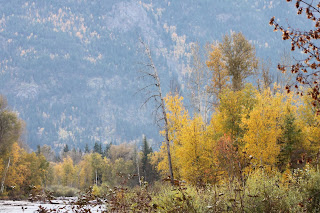We park our truck in the lot and take off walking down the path close to the river. The Park wardens have made signs and posted them along the way to mark where the salmon currently are spawning. It is a typical cooler fall day today.
Approximately 15 million Fraser River Sockeye Salmon will return home after 2 years roaming the broad Pacific Ocean. They will battle the turbulent Fraser River and the Thompson River 500 km back to the streams that gave them life almost four years earlier. The 12 km Adams River will be the ultimate destination of as many as 2 million returning sockeye salmon. Sockeye Salmon return to the Adams River every year, but every fourth year there are peak numbers reaching as high as 3.6 million (in 2002). Four years earlier the parents of the returning Sockeye followed the same waterways, mated, laid their eggs in the coarse gravel stream beds and then died.
When the salmon pair up, the female digs a nest and deposits approx 3,500 eggs and the male then fertilizes the eggs. The pair cover the eggs with gravel to protect them from other fish and birds. Within the next couple of weeks the crimson pair turn to a chalky grey color and die.
The eggs slowly develop through the winter and with the warming waters of April the tiny fingerlings leave the gravel beds and travel down to the Shuswap Lakes. They stay in the lake for a year feeding in the shallower waters. Then in May and June of their second year, they again ride the waters down the 480 km through the rapids of the Thompson and Fraser Rivers to the Pacific Ocean. Of an estimated 100 million Sockeye Salmon fingerlings that leave the Shuswap Lake in the spring of a peak year, approximately only ten per cent are expected to return to the B.C. coast in the autumn four years later. The rest are lost to natural predators and ocean going fishing vessels.
The Sockeye Salmon are the second smallest of the five species of Pacific Salmon. It will take them seventeen days to return to their spawning grounds. They will travel at an average of 30 km a day and will live off of the fat stored in their bodies during the two year say in the Pacific salt waters. As their upstream battle consumes their body fat they under go a transformation. Their deep sea blue-gray bodies gradually change to a brilliant crimson red. In addition, the male of the species has become grotesquely distorted with a hump back and a sharply hooked nose on his green head.
We are a little late in the season as the main run has already happened. We still see a lot of crimson colored salmon swimming and jumping in the river. We also see several dead silver salmon close to the shores in the shallow waters and we also smell them, too. I think next year we will time our trip to come earlier in the fall and bring a better lens for taking pictures of the fish. The stop was still worth our time and was very educational. There are several educational signs and a information centre in the park.
 |
| Adams River, B.C. |




No comments:
Post a Comment